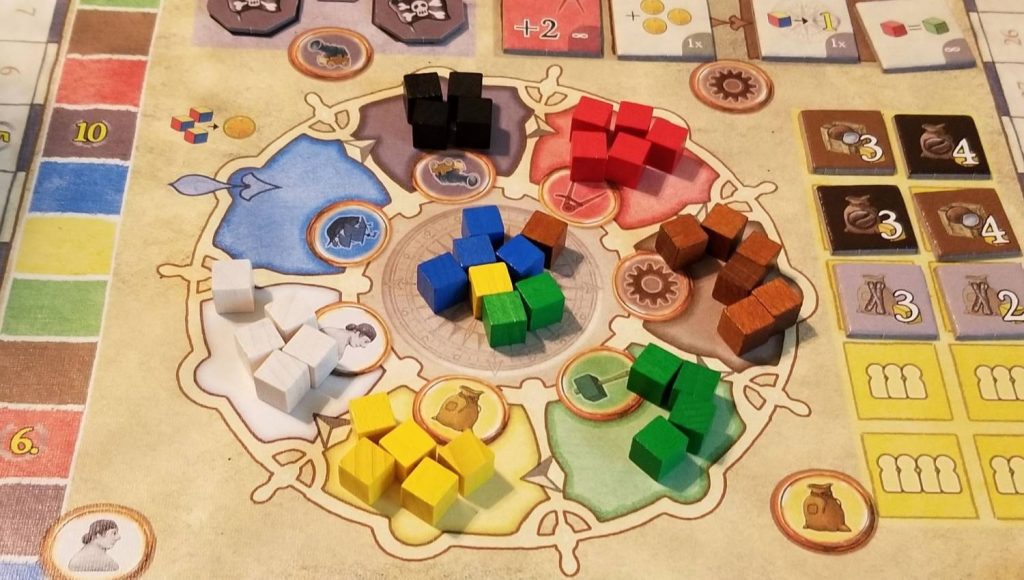Hello and welcome to ‘Focused on Feld’. In this series of reviews, I am working my way backwards through Stefan Feld’s entire catalogue. Over the years, I have hunted down and collected every title he has ever put out. Needless to say, I’m a fan of his work. I’m such a fan, in fact, that when I noticed that there were no active Stefan Feld fan groups active on Facebook, I created one of my own.
Today we’re going to talk about 2013’s Amerigo, his 19th game.
Amerigo holds several distinctions within the Feldiverse. For beginners, Amerigo was the first ever crowdfunded Feld title. Secondly, it was Stefan Feld’s very first game to feature a cube tower (his upcoming title, Marrakesh also uses one). And lastly, Amerigo has a box far larger than any of his other games (at least for now). In a 2019 interview with Dice Tower’s Jason Levine, Stefan Feld hinted that he was working on a game featuring miniatures. Will Amerigo be dethroned by an even bigger game? I guess we’ll see!
Overview
In Amerigo, the players take on the roles of explorers much like Amerigo Vespucci—a famous 15th century Italian explorer (America is named after him)—as they sail the seas, discover new lands, and colonize them.
The game is played over five rounds that each consist of seven different actions. The actions available during a round are dictated by cubes tossed through a cube tower and which of them shake out at its base.
Almost every action in the game has the potential to score points. These actions allow you to do things such as move your boats around the playing area to explore the islands and set up shop, gain building tiles (and then actually build them), and add cannons to your ships in order to ward off the pirate threat that looms at the end of each round. When the game finally comes to an end after the fifth round, the player with the highest victory point total wins the game.
Of course, this is a very high level overview of the game. If you’re already familiar with the mechanics and/or just want to know what I think, then feel free to skip ahead to the Thoughts section. Otherwise, read on as we talk about how to play Amerigo.
The Expedition Begins
A game of Amerigo is set up thusly:

First, the border is assembled according to player count and then a number of randomly selected Island tiles are placed within the frame. If any of the resulting land structures number twenty spaces or more, they have a treasure chest placed on top of them. Any commodity spaces (of which there are five types) are covered with matching Commodity tokens. The Time marker stack is formed by placing the markers atop one another in descending order and then placed on top of the matching space along the border.
Next to this is the Storage board, which is populated with five face-down Pirate tokens (out of a total of six), a number of Production (based on player count), and eight Progress tokens. The cube tower is assembled and placed close by. Then, all the cubes are tossed into the tower and the ones that fall out are arranged by color and placed into their proper positions on the Storage board. All the neutral landscape tiles are arranged by size and stored off to the side.

Each player then chooses a color and receives the trading posts, ships, scoring/victory point/player order discs, victory point tile, and village tiles of their chosen color. They also receive a player sheet. Each player sets a disc on the zero spaces of the gold, cannons, and progress tracks on their player sheet. They also set a disc on the zero spaces of the score track and special action track on the Storage board. The discs on the special action track are placed in turn order, with the first player on top and the last player on bottom. Each player will begin the game with some gold based on their position in turn order. Their personal supply of village tiles is added to the supply of neutral landscape tiles.
Now, you’re ready to play Amerigo.
The Voyage is Underway
Amerigo is played over the course of five rounds. Each of these is divided into seven phases. The phases are: move ships(blue), load cannons(black), plan(red), progress(brown), build(green), buy production tokens(yellow), and special action(white). These phases are played in order. At the beginning of each phase, the cubes matching the phase are collected from the Storage board and dropped into the tower. The cubes that fall out determine a. the actions available for that phase and b. the maximum power that can be applied to a chosen action. On their turns, each player will select exactly one of the available actions to perform up to its maximum power.
To better explain that, consider this example:

It is currently the ‘move ships’ phase. The blue cubes have been collected and dropped into the tower. Four blue cubes have fallen out as well as one yellow, two green, and one brown. This means that the actions available to the players are: move ships, buy production tokens, build, and progress. The maximum power that can be applied to any of these actions is four, the total number of the color with the highest number of cubes (which, in this case, is blue).
So, what do the different actions do? Glad you asked. Here’s a brief rundown on what they do, by color, along with how they affect scoring (if at all).
Blue: move both of your ships up to a number of spaces equal to the action’s power. If you land on an anchor, you can establish a trading post on the neighboring island. If you’re the first to establish a trading post on the island, you score three points.
Black: raise your cannons an amount equal to the action’s power. If this would move you past twelve, then you also gain two gold.
Red: purchase tiles from the neutral landscape tile supply (or your own) up to the action’s power and add them to your supply. For instance, if the action’s power is six, you could buy a neutral landscape tile worth six OR you could buy a neutral landscape tile worth two and up to four of your personal tiles. Neutral tiles cost more but are worth more points when building.
Brown: move your progress marker along the progress track on your Player board an amount equal to the action’s power. If this should land on or pass one of the numbered spaces, then you can collect the Progress token of your choice from the Storage board and add it to your Player board where you can begin using its benefits—gain extra action points when using specific actions, get free gold, etc. The further you move along the progress track of your Player board, the more points you’ll earn at the end of the game.
Green: add purchased tiles from your supply to the island tiles up to an amount equal to the action’s power and earn points for them, depending on the type of island—small or large. If your building tile should cause the island to become entirely filled in, everyone with trading posts on that island earns points. The earlier in the game this happens, the more points you’ll earn. If your added tile covers a commodity, then collect the token and add it to your Player board.
Yellow: purchase Production tokens from the Storage board up to the action’s power. For instance, if the action’s power is seven, you could buy a Production token with a 4 printed on it and a token with a two OR you could purchase three tokens with twos on them, etc. At the end of the game, you’ll earn points for each Production token times the total number of the matching commodity you’ve collected.
White: either move your disc a number of spaces on the special action track equal to the action’s power OR perform the action matching the color that your special action disc is currently sitting on. The further you move along the track, the earlier you’ll be in the upcoming turn order and the more points you’ll earn at the end of the game.
Gain gold: if you choose to do so, you can forgo performing any of the available actions and gain gold instead. Count up the number of cubes, divide by three, and round up. That’s how much gold you receive. Gold can be spent at a 1:1 ratio to increase an action’s power. It’s also worth one victory point per gold at the end of the game.
And that’s how you play Amerigo. There are a few fiddly details here and there that I left out, but those are the basics. It may be a little difficult to wrap your head around how everything works at first, but after a couple of rounds you’ll get it. Just keep in mind that at the end of each round, the pirates are going to attack and you’ll have to fend them off by spending cannons or lose victory points (along with the cannons) if you’re unable to.
Thoughts
Looking back, I think I can say with some certainty that the Thursday of GenCon 2017 was the day that I went from being a fan of Stefan Feld’s games to an outright collector. That’s the day that In the Year of the Dragon, Notre Dame, and Amerigo entered my collection. For two of those, it was my first ever interaction with them. Not so with Amerigo.
My history with Amerigo began several months before that particular GenCon. My wife and I had traveled across town to a couple’s house that we were friends with for a night of boardgaming bliss. I don’t recall much about that evening other than playing Amerigo and being so enamored with it that I offered to buy it from them on the spot, an offer which they politely declined. And having discovered Amerigo and having made an attempt to buy it once already, I knew that I needed the game in my collection.
After purchasing it at GenCon, I excitedly brought it home…where it sat on the shelf for five years. And now, after pulling it down, dusting it off, and playing through it multiple times for the purposes of writing this review, I am wondering what the heck I was thinking by leaving it unplayed for so long. Because, let me tell you, Amerigo is pretty spectacular.

The first thing that catches your attention when encountering Amerigo in the wild is the beautiful illustration on the box top. Without even cracking the game’s sizable lid, you already know what this game is about. The rugged explorer, robes and hair billowing in the oceanic breeze. The men unloading a boat onto the beach. The birds flying in the background. The image speaks volumes. You can almost smell the air and hear the waves and feel the sand beneath your toes. It’s a powerful image that encourages you to dig deeper, to rip off the plastic and discover what waits inside.
And, oh, what a treat that is!
After lifting off the lid and removing the printed material, you are immediately greeted with one of the most well-crafted inserts you’ll ever lay your eyes upon. I know. I know. It’s hard to be impressed by something as simple as an insert these days with companies like Meeple Realty and GameTrayz competing for your business. But back in 2013, the insert inside of this box was the pinnacle of insert achievement. There’s a place for everything and everything fits nicely in its place. Plus, there’s no wasted space. This box is exactly as large as it needs to be. It’s beautifully engineered. And when you open it, you’ll see what I mean. It’s hard not to nod your head approvingly. The rest of the components aren’t half bad either. That’s not surprising for a Queen Games product. If there’s one thing they consistently get right, it’s high production quality.
But what I really appreciate is Stefan Feld’s brilliant design. In fact, Amerigo may be Stefan Feld’s best design ever. As of this writing, he’s got thirty-two published games under his belt, so that’s saying a lot.
I think it comes down to variability. From the initial placement of the island tiles to the way the cube tower works, no two games will ever play out quite the same. This means that there is no dominant strategy. What worked last game may not (and probably won’t) work this game. The only thing I’ve noticed that repeats itself from one game to the next is the rush to establish trading posts on the islands. But eventually, the players begin to focus their efforts elsewhere as the act of sailing becomes less lucrative, when reaching the last few ports becomes a carefully measured judgment call. Is it worth the expenditure of valuable action points or are those points better spent elsewhere? And that is the question central to this game.
Action points are the driving force behind everything and sometimes (okay, many times) those action points are scarce. The great thing about Amerigo is that this scarcity affects everyone in exactly the same way. Everyone has the exact same pool of actions available to them, so it’s interesting seeing how each person’s path diverges from the others’.
Sadly, though, other than the rush to out-establish trading posts and the move to strategically block opponents from building on islands through clever tile placement (to place a tile, you have to be able to establish a path through a combination of neutral and your own tiles back to one of your trading posts), there isn’t much player interaction. Despite the shared island space, Amerigo is largely a solitary affair. That may dissuade some from ever even giving it a try.
And that would be a shame. They don’t know what they’re missing.











Add Comment